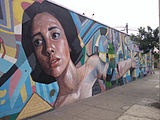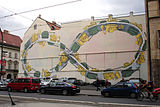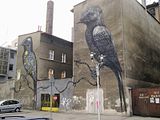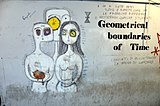Street art

Street artisvisual artcreated in public locations for public visibility. It has been associated with the terms "independent art", "post-graffiti", "neo-graffiti" andguerrilla art.[2]
Street art has evolved from the early forms of defiantgraffitiinto a more commercial form of art, as one of the main differences now lies with the messaging. Street art is often meant to provoke thought rather than rejection among the general audience through making its purpose more evident than that of graffiti. The issue of permission has also come at the heart of street art, as graffiti is usually done illegally, whereas street art can nowadays be the product of an agreement or even sometimes a commission. However, it remains different from traditional art exposed in public spaces by its explicit use of said space in the conception phase.
Background[edit]
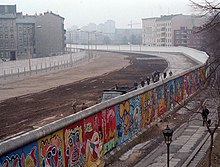
Street art is a form of artwork that is displayed in public on surrounding buildings, on streets, trains and other publicly viewed surfaces. Many instances come in the form of guerrilla art, which is intended to make a personal statement about the society that the artist lives within. The work has moved from the beginnings of graffiti and vandalism to new modes where artists work to bring messages, or just beauty, to an audience.[3]
Some artists may use "smart vandalism" as a way to raise awareness of social and political issues,[4]whereas other artists use urban space as an opportunity to display personal artwork. Artists may also appreciate the challenges and risks that are associated with installing illicit artwork in public places. A common motive is that creating art in a format that utilizes public space allows artists who may otherwise feel disenfranchised to reach a much broader audience than other styles or galleries would allow.
Whereas traditionalgraffitiartists have primarily usedspray paintto produce their work, "street art" can encompass other media, such asLED art,mosaictiling,stencil art,sticker art,reverse graffiti,"Lock On" sculptures,wheatpasting,woodblocking,yarn bombingandrock balancing.[5]
New media forms such as video projections onto large city buildings are an increasingly popular tool for street artists—and the availability of cheap hardware and software allows such artwork to become competitive with corporate advertisements. Artists are thus able to create art from their personal computers for free, which competes with companies' profits.[6]
Origins[edit]

Slogans of protest and political or social commentary graffiti on walls are the precursor to modern graffiti and street art, and continue as one aspect of the genre. Street art in the form of text or simple iconic graphics of corporate icons can become well-known yet enigmatic symbols of an area or an era.[7]Some credit theKilroy Was Heregraffiti of the World War II era as one such early example; a simple line-drawing of a long-nosed man peering from behind a ledge. AuthorCharles Panatiindirectly touched upon the general appeal of street art in his description of the "Kilroy" graffiti as "outrageous not for what it said, but where it turned up".[8]Much of what can now be defined as modern street art has well-documented origins dating fromNew York City'sgraffiti boom,with its infancy in the 1960s, maturation in the 1970s, and peaking with the spray-painted full-car subway train murals of the 1980s centered inthe Bronx.
As the 1980s progressed, a shift occurred from text-based works of early in the decade to visually conceptual street art such asHambleton's shadow figures.[9]This period coincides withKeith Haring's subway advertisement subversions andJean-Michel Basquiat'sSAMOtags. What is now recognized as "street art" had yet to become a realistic career consideration, and offshoots such asstencil graffitiwere in their infancy.Wheatpastedposter art used to promote bands and the clubs where they performed evolved into actual artwork or copy-art and became a common sight during the 1980s in cities worldwide.[citation needed] The group working collectively asAVANTwas also active in New York during this period.[10]Punk rock music's subversive ideologies were also instrumental to street art's evolution as an art form during the 1980s. Some of the anti-museum mentality can be attributed to the ideology ofMarinettiwho in 1909 wrote the "Manifesto of Futurism"with a quote that reads," we will destroy all the museums. "[11]Many street artists claim we do not live in a museum so art should be in public with no tickets.[11]
Early iconic works[edit]
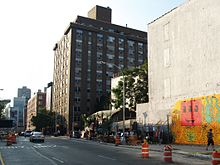
The northwest wall of the intersection atHouston Streetand theBoweryin New York City has been a target of artists since the 1970s. The site, now sometimes referred to as theBowery Mural,originated as a derelict wall that graffiti artists used freely.Keith Haringonce commandeered the wall for his use in 1982. After Haring, a stream of well-known street artists followed, until the wall had gradually taken on prestigious status. By 2008, the wall became privately managed and made available to artists by commission or invitation only.[citation needed]
A series of murals byRené Moncadabegan appearing on the streets ofSoHoin the late 1970s emblazoned with the wordsI AM THE BEST ARTIST.René has described the murals as a thumb in the nose to the art community he felt he had helped pioneer but by which he later felt ignored by.[7][12]Recognized as an early act of "art provocation",[13]they were a topic of conversation and debate at the time; related legal conflicts raised discussion about intellectual property, artist's rights and theFirst Amendment.[14][15][16][17]The ubiquitous murals also became a popular backdrop to photographs taken by tourists and art students, as well as for advertising layouts and Hollywood films.[18][19][20] IATBAmurals were often defaced, only to be repainted by René.[13][21]
Franco the Great,also known as the "Picasso of Harlem" is another world famous street artist internationally known also for his New Art form. There were riots in the streets whenMartin Luther King Jr.was assassinated in 1968.Harlem business owners retaliated by installing drab-looking metal gates on their storefronts. Franco decided to turn a negative into a positive by developing a new art form on the steel gates in 1978. He has painted over 200 gates from the west to the east side of 125th street on Sundays since then, when stores are closed. "125th Street in Harlem is unofficially known as" Franco's Blvd "because of his magnificent paintings on the metal business gates.[22]
Commercial crossover[edit]
Some street artists have earned international attention for their work and have made a full transition from street art into the mainstream art world—some while continuing to produce art on the streets.Keith Haringwas among the earliest wave of street artists in the 1980s to do so. Traditional graffiti and street art motifs have also increasingly been incorporated into mainstream advertising, with many instances of artists contracted to work as graphic designers for corporations. Graffiti artistHazehas provided font and graphic designs for music acts such as theBeastie BoysandPublic Enemy.Shepard Fairey's street posters of then-presidential candidateBarack Obamawere reworked by a special commission for use in the presidential campaign. A version of the artwork also appeared on the cover ofTimemagazine. It is also not uncommon for street artists to start their own merchandising lines.[citation needed]
Street art has received artistic recognition with the high-profile status ofBanksyand other artists. This has led street art to become one of the 'sights to see' in many European cities. Some artists now provide tours of local street art and can share their knowledge, explaining the ideas behind many works, the reasons for tagging, and the messages portrayed in a lot of graffiti work. Berlin, London, Paris, Hamburg and other cities all have popular street art tours running all year round. In London alone there are supposedly ten different graffiti tours available for tourists.[23]Many of these organizations, such as Alternative London,[24]ParisStreetArt,[25]AlternativeBerlin,[26]pride themselves on working with local artists, so visitors can get an authentic experience and not just a rehearsed script.
Many of these guides are painters, fine-art graduates and other creative professionals that have found the medium of street art as a way to exhibit their work. With this commercial angle, they can let people into the world of street art and give them more of an understanding of where it comes from. It has been argued that this growing popularity of street art has made it a factor ingentrification.[27]
Legality and ethics[edit]
Street art can have legal problems. The parties involved can include the artist, the city or municipal government, the intended recipient and the owner of the structure or the medium where the work was displayed. One example is a case in 2014 in Bristol, England, which illustrates the legal, moral and ethical questions that can occur. TheMobile LoversbyBanksywas painted on plywood on a public doorway, then cut out by a citizen who in turn was going to sell the piece to garner funds for a boys' club. The city government in turn confiscated the artwork and placed it in a museum. Banksy, hearing of the conundrum, then bequeathed it to the original citizen, thinking his intentions were genuine. In this case, as in others, the controversy of ownership and public property, as well as the issues of trespassing and vandalism, are issues to be resolved legally.[28]
Copyright[edit]
Under United States law, works of street art should be able to find copyright protection as long as they are legally installed and can fulfil two additional conditions; originality in the work, and that it is fixed in a tangible medium.[29]This copyright would then survive for the lifespan of the artist plus 70 years.[30]In case there is a collaboration between two artists, both would hold joint ownership in the copyright.[31]Street artists also holdmoral rightsin their work, independent of economic rights arising from copyright. These include the right to integrity and the right to attribution.[32] Recently, street art has started to gain recognition among art critics, and some major companies have found themselves in trouble for using this art without permission for advertising. In such a case,H&M,afast fashionretailer used street art by Jason "Revok" Williams in an advertisement series.[33]In response to Williams' 'Cease and Desist' notice, however, H&M filed a lawsuit, alleging that since the work is a "product of criminal conduct", it cannot be protected by copyright. This view has been taken earlier too, in the cases of Villa v. Pearson Education[34]andMoschinoand Jeremy Tierney.[35]In all three cases, before the judge could make a ruling on the issue of the illegality of the art, settlements were reached.[36]These companies typically settle out of court to avoid costly, time-consuming litigation.
When it comes to the question of the destruction of street art, the United States has applied theVisual Artists Right Act (VARA)[37]to introduce moral rights into copyright law. InEnglish v. BFC & R East 11th Street LLCandPollara v. Seymour,it was held that this Act was inapplicable to works of art placed illicitly. A distinction was also made between the removable and nonremovable works, indicating that if a work can be removed trivially, it cannot be destroyed, irrespective of its legal status.[38]Another important factor considered by the court in the latter case was whether the artwork was "of a recognized stature".[36]
In a case where a group of artists was awarded $6.7 million, the judge held that the art was not made without permission of the owner of the building, and that an important factor was that the demolition was done ahead of the intended date, indicating willful thought.[39]
Street art, guerrilla art and graffiti[edit]

Graffiti is characteristically made up of written words that are meant to represent a group or community in a covert way and in plain sight. The telltale sign of street art is that it usually includes images, illustrations, or symbols that are meant to convey a message.[40]While both works are meant to represent or tell a message to viewers, one difference between the two comes in the specific viewers that it is meant for. One trait of street art that has helped to bring it to positive light in the public eye is that the messages shown are usually made to be understandable to all.[40]
While both of these types of art have many differences, there are more similarities than their origins. Both graffiti and street art are works of art that are created with the same intent. Most artists, whether they are working anonymously, creating an intentionally incomprehensible message, or fighting for some greater cause are working with the same ambitions for popularity, recognition and the public display or outpouring of their personal thoughts, feelings and passions.[40]
The term street art is described in many different ways, one of which is the term "guerrilla art". Both terms describe these public works that are placed with meaning and intent. They can be done anonymously for works that are created to confront taboo issues that will result in a backlash, or under the name of a well-known artist. With any terminology, these works of art are created as a primary way to express the artist's thoughts on many topics and issues.[41]
As with graffiti, an initial trait or feature of street art is that it is often created on or in a public area without or against the permission of the owner.[42]A main distinction between the two comes in the second trait of street art or guerrilla art, where it is made to represent and display a purposefully uncompliant act that is meant to challenge its surrounding environment.[42]This challenge can be granular, focusing on issues within the community or broadly sweeping, addressing global issues on a public stage.
This is how the term "guerrilla art" was associated with this type of work and behavior. The word ties back to guerrilla warfare in history where attacks are made wildly, without control and with no rules of engagement. This type of warfare was dramatically different from the previously formal and traditional fighting that went on in wars normally. When used in the context of street art, the term guerilla art is meant to give a nod to the artist's uncontrolled, unexpected and often unnamed attack on societal structure or norms.[43]
Some have asked if it is sufficient to place art in the street to make street art; Nicholas Riggle looks more critically at the border between graffiti and street art and states that "an artwork is street art if—and only if—its material use of the street is internal to its meaning".[44]The street is not a blank canvas for the street artist. It has a character, a use, a history, a texture, a shape. Street art, as well as broader urban art, transforms the street or opens the dialogue. Justin Armstrong states graffiti is identified as an aesthetic occupation of spaces, whereas urban street art repurposes them.[45]
Guerilla sculpture[edit]
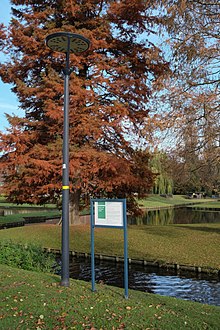
Guerilla sculpture is the placement of sculptures in street settings without official approval; it developed from street art in England in the late 20th century.[43]In addition to the nontraditional setting of the works of art involved, there are also many different techniques used in the creation of this artwork. The artists tend to work illegally and in secrecy to create and place these works in the dark of night, cloaked in mystery regarding their origins and creators. The sculptures are used to express the artist's views and to reach an audience that would not otherwise be reached through more traditional methods of displaying one's work to the public. In performing these acts of artistic expression, they are not working to gain acceptance or love of the people that they reach, but at times may even anger those who view their work.[43]
An example is the overnight appearance of an unsanctioned sculpture ofEdward Snowdenonto a column inFort Greene Parkin New York City.[43]In other cases, the sculptures integrate two-dimensional backdrops with a three-dimensional component, such as one by Banksy titledSpy Booth(2014). The backdrop was painted on a wall in Cheltenham, England and featuredCold-Warspy characters adorned in trench coats and fedoras, with spy accoutrements, microphones and reel-to-reel tape decks. These characters appeared to betapping intoa broken telephone booth.[43]
On 15 July 2020, a month after the statue ofEdward Colstonwas pulled down duringBlack Lives Matterprotests inBristol,artistMarc Quinnused the empty plinth to display his sculptureA Surge of Power (Jen Reid).The life-sized piece, created from black resin and steel,[46]was inspired by a picture of protester Jen Reid, raising her fist during the Bristol protest that subsequently went viral and caught the attention of Quinn. The statue was removed by Bristol City Council on 16 July 2020.[47]
A deviation from the unsanctioned street sculpture is "institutionalized guerilla sculpture", which is sanctioned by civic authorities and can be commercialized. One such artist from the Netherlands isFlorentijn Hofman,who in 2007 createdRubber Duck,a colossal rendition of the childhood tub-toy.
In Latin America, especially Mexico, the termantimonumentohas developed as the equivalent to political guerilla sculpture, or simply, an illegal installation of a politically themed sculpture. They are used to denounce the inaction of the state and reclaim public space.[48]Normally anantimonumentois installed during a demonstration[48]and, asMárcio Seligmann-Silvawrites, "corresponds to a desire to actively recall the (painful) past."[49]Some of the issues commemorated are disappearances, massacres, migration, and the killing of women.[50] They are used to denounce the inaction of the state and reclaim public space.
Public acceptance[edit]
Although street art may be ubiquitous around the world, the popularity of its artistic expression is relatively recent. Street art has undergone a major transformation in public opinion to become socially accepted and respected in some public places.[42]Even with this degree of acceptance, defacing private or public property with any and all message, whether it is considered art or not, is still widely illegal.[42]
In the beginning, graffiti was the only form of street art that there was and it was widely considered to be a delinquent act of territorial marking and crude messaging. Initially, there were very clear divisions between the work of a street artist and the act of tagging a public or private property, but in recent years where the artists are treading the line between the two, this line has become increasingly blurred.[42]Those who truly appreciate the work of famed street artists or street works of art are in acceptance of the fact that this art would not be the same without the medium being the street. The works are subject to whatever change or destruction may come because since they are created on public or private surfaces which are neither owned by the artist or permitted to be worked on by the property owners. This acceptance of the potential impermanence of the works of art and the public placement of the uncondoned works are what contribute to the meaning of the piece and therefore, what helps the growth of street art popularity.[42]In the 21st century, a number of American cities began installing poetry intosidewalkcement, sometimes holding public contests to choose new poems.[51][52][53]
Perhaps contrary to earlier anti-museum and ticket sale sentiments of some street artists; a dedicated exhibition to Street Art under the title 'Urban' opened inPeterborough Museum,United Kingdom, on the 11th December 2021. With tickets for the preview evening selling at £5 GDP and subsequent entry being charged at £8 per person. The exhibition has been promoted as being of 'major national [UK] importance' and celebrating artists such as Banksy,Damien Hirst,My Dog Sighs, the Connor Brothers, Pure Evil andBlek le Rat.[54]While street art and sculpture has been on display atBristol Museumsince aBanksy'takeover' in 2009.[55]
Beautification movement[edit]
Given the various benefits and sometimes high return on investment[56]street art provides businesses, schools, neighborhoods and cities with a movement as a tool to create safer, brighter, more colorful and inspiring communities, a trend which has recently been more widely recognized. Organizations likeBeautify Earthhave pioneered cities to leverage these benefits to create widespread beauty where it would be otherwise empty or dilapidated public wall space.[57]
AThe Washington Postarticle written by Sydney Page has stated that according to a safety study produced by Bloomberg Philanthropies in partnership with the consulting firm Sam Schwartzentitled "Asphalt Art Safety Study", crosswalks painted with murals have been found to significantly reduce the frequency of accidents occurring at such sites.[58]
North America[edit]
Canada[edit]
InMontreal,with over 80 murals and counting since the foundation ofMURAL Festivalin 2013, the annual street art festival contributed to creatingLe Plateau-Mont-Royalas an epicenter for urban arts.Villeray,Downtown MontrealLe Sud-Ouest,Hochelaga-Maisonneuve,and multiple art districts also continue to broaden the street art circuit within the Island of Montreal.[citation needed]The Under Pressure annual graffiti festival, the largest of its kind in North America, celebrated its 25th anniversary in 2021.[59]
Torontohas a significantgraffiti scene.[60]
Calgary,while historically having a smaller graffiti street art scene, recently started the Beltline Urban Mural Project (BUMP) with artists from all over the world creating large murals in the city center.[61]
United States[edit]

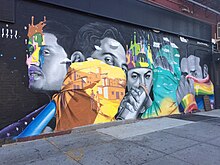
New York Cityattracts artists from around the world.[62] InManhattan,"post-graffiti" street art grew in the 1980s from the then largely vacant neighborhoods ofSoHoand theLower East Side.TheChelseaart district became another locale, with area galleries also hosting formal exhibitions of street artist's work. InBrooklyn,theWilliamsburgandDumboneighborhoods—especially near the waterfront—are recognized street art sites.[63]New York City's unofficial Mural District is in Brooklyn's Bushwick neighborhood, with curatorial gatekeeping by a non-profit organization called TheBushwick Collective.
Chicagohas many forms of street art emerging but some of the most popular artists that can be seen everywhere in Chicago is Sentrock, Jc Rivera (The Bear Champ), and Hebru Brantley.
Programs in thePennsylvaniacities ofPhiladelphiaandPittsburghprovide funding to agencies who employ street artists to decorate city walls. TheMural Arts Programestablished in 1984 has helped Philadelphia earn praise as the "City of Murals". The project was initiated to encourage graffiti artists toward a more constructive use of their talents. Murals backed byThe Sprout Fundin Pittsburgh were named the "Best Public Art" by thePittsburgh City Paperin 2006.[64][65]

Street art in Atlantacenters on theOld Fourth WardandReynoldstownneighborhoods, theKrog Street Tunnel,and along the 22-mileBeltLinerailway corridor which circles the inner city. Atlanta established a Graffiti Task Force in 2011. Although the city selected a number of murals that would not be targeted by the task force, the selection process overlooked street art of the popular Krug Street Tunnel site. Art created in conjunction with theLiving Wallsstreet art conference, which Atlanta hosts annually, was spared. Some actions were taken by the unit, including arrests of artists deemed vandals, caused community opposition; some considered the city's efforts as "misdirected" or "futile".[66][67]After being sued by a group of artists in 2017 the city of Atlanta agreed not to enforce an ordinance requiring artists to obtain city approval for murals on private property.[68]Images and locations of over 200 works of Atlanta street art can be found on the Atlanta Street Art Map.[69]
Sarasota,Florida, hosts an annual street art event, theSarasota Chalk Festival,founded in 2007. An independent offshoot known asGoing Verticalsponsors works by street artists, but some have been removed as controversial.[70][71]
Los Angeles'sArts Districtis known for its high concentration street murals.[72]The neighborhood ofHollywoodand streets such asSunset Boulevard,La Brea,Beverly Boulevard,La Cienega,andMelrose Avenueare among other key locations.[73]LAB ART Los Angeles,opened in 2011, devotes its 6,500 square feet of gallery space to street art. Artwork by locals such asAlec Monopoly,Annie Preece,SmearandMorleyare among the collection.
San Francisco'sMission Districthas densely packed street art along Mission Street, and along bothClarionandBalmy Alleys.[74] Streets ofHayes Valley,SoMa,Bayview-Hunters Pointand theTenderloinhave also become known for street art.[75]
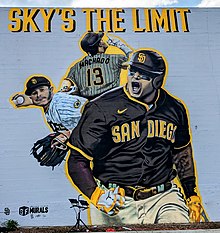
San Diego's East Village, Little Italy, North Park, and South Park neighborhoods contain street artwork ofVHILS,Shepard Fairey,Tavar Zawacki a.k.a.ABOVE,Space Invader,Os Gêmeos,among others. Murals by various Mexican artists can be seen atChicano Parkin theBarrio Loganneighborhood.Chicano Park,which was a part of people’s land takeover in 1970, celebrated its 52nd anniversary in 2022. The more than 80 murals depict many aspects of Latino culture fromlowrider culturetoAztec warriors.[76]Since the COVID-19 pandemic, Ground Floor Murals has created works that recognize the multicultural communities of San Diego, including Mexican singerVicente Fernández,[77]players from theSan Diego Padres,and important local community members.[78]Their first mural was of Padres’ legend,Tony GwynninCity Heights.[79]
Richmond,Virginia has over 100 murals created by artists, many of whom are alumni ofVirginia Commonwealth University's School of the Artsor current students there. Some of the murals are privately commissioned by individuals and businesses, some are created by solo street artists, and some are collaborative group fund-raising projects.[80]
Denverstreet artists have been busy brightening (and enlightening) the urban landscape for decades by making canvases of the city's alleyways, building exteriors, warehouses, garage doors and storefronts.[81]The city of Denver has a whole area called the River North Art District (RiNo) that is dedicated to the work of local creative artists. Most artists in the RiNo district are commissioned by the local business owners who want to give their buildings colorful imagery.[citation needed]
Mexico[edit]
The manifestations of street art in Mexico began in the late 80s in Mexico City, inside multifamily buildings in the north of the city and also in the subway. Since then, urban art and graffiti have formed an essential part of cultural identity in the different city halls of the metropolis. Currently, some different associations and groups are dedicated to the creation and search of spaces for urban art in Mexico City and throughout the country. Even several artists, both national and foreign or emerging and consolidated, have taken their art to the Latin American country.

There are also media, such as All City Canvas,[82]specialized in the dissemination of urban art in Mexico, Latin America and the rest of the world. In that way, it has been possible to create a universal language around this artistic manifestation. Even in 2012, All City Canvas was the first organization to create a street art festival in Mexico that sought to join international efforts and create urban art for a week in Mexico City. In recent years, they have produced several murals in collaboration with talented artists such asVhils,It's a Living and Bier in Brood,[83]as part of the All City Canvas Global Series[84]in some cities in Mexico and the United States. The objective of the initiative is to create an impact on society through a large-scale piece of art.
South America[edit]
Buenos Aireshas developed a reputation for its large scale murals and artworks in many subway stations and public spaces. The first graffiti artists started painting in the street in the Argentine capital in the mid-1990s after visiting other countries in Europe and South America. One of the first recognized street artists in Argentina is Alfredo Segatori, nicknamed 'Pelado', who began painting in 1994 and holds the record for the largest mural in Argentina[85]measuring more than 2000 square meters.
An abundance of buildings slated for demolition provides blank canvases to a multitude of artists, and the authorities cannot keep up with removing artists' output. "Population density" and "urban anxiety" are common motifs expressed by "Grafiteiros" in their street art andpichação,rune-like black graffiti, said to convey feelings of class conflict.
Influential Brazilian street artists include Claudio Ethos,Os Gêmeos,Vitche, Onesto, and Herbert Baglione.[86][87]
Bogotáhas a lot of walls dedicated to street art and a powerful artistic movement. The tourist can appreciate several wall performances:Avenida El Dorado (TransMilenio),Avenida Subaand the historical neighborhoodLa Candelaria.Also, there is the Distrito graffiti (graffiti district), that is a dedicated place with gubernatorial curatory with more than 600 pieces of Colombian and international artists.[88]
Caracasat the beginning this art the works had a more cultural air, much of the first street arts in the country were related to politics. Messages of disagreement or support for the leaders of the moment predominated. Over the years, street art in Venezuela has evolved. The works with political accents continued to star in the streets of the country, but culture became part of the arena.
Europe[edit]
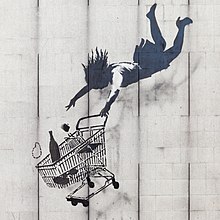
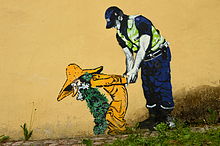
Londonbecame one of the most pro-graffiti cities in the world in the 2010s. Although officially condemned and heavily enforced, street art has a huge following and in many ways is embraced by the public, for example,Stik's stick figures.[90]Dulwich Outdoor Gallery,in collaboration withStreet Art London,is an outdoor "gallery" of street art inDulwich,southeast London, with works based on traditional paintings inDulwich Picture Gallery.[91]
Bristolhas a prominent street art scene, due in part to the success ofBanksy,[92]with many large and colorful murals dominating areas of the city.
Ostend, Belgium,hosts an international street art festival. In 2018, US art magazine Juxtapoz described The Crystal Ship as "an art festival that is quickly becoming one of the major annual street art events in the world". Today, it is just that. Having seen the light of day in 2016, every year, The Crystal Ship paints the town of Ostend red (and blue, and green, and yellow, and quite possibly every other colour you can imagine) by inviting a host of acclaimed street artists to get inspired by its people, landscape, and heritage. Curator Bjorn Van Poucke is the driving force behind this street art walhalla, where the work of artists like Axel Void (USA), Paola Delfín (Mexico), Escif (ES), Miss Van (FR), Sebas Velasco (ES), Elian (AR) and Wasted Rita (PT) transform the city.
Parishas an active street art scene that is home to artists such asSpace Invader,Jef Aérosol,SP 38andZevs.Some connect the origins of street art in France toLettrismof the 1940s andSituationistslogans painted on the walls of Paris starting in the late 1950s.Nouveau realistsof the 1960s, includingJacques de la Villeglé,Yves KleinandArmaninteracted with public spaces but, likepop art,kept the traditional studio-gallery relationship. The 1962 street installationRideau de Fer(Iron Curtain) byChristo and Jeanne-Claudeis cited as an early example of unsanctioned street art. In the 1970s, the site-specific work ofDaniel Burenappeared in the Paris subway.Blek le Ratand theFiguration Libremovement became active in the 1980s.[citation needed][93]The 13 arrondissement is actively promoting street art through the Street Art 13 project. That includes two remarkable frescos by D*Face from London: "Love will not tear us apart" and "Turncoat".[94]Between October 2014 and March 2015, Fondation EDF hostedJérôme Catz's exhibition "#STREET ART, L'INNOVATION AU CŒUR D'UN MOUVEMENT", which featured new technologies integrated with pieces by artists including Shepard Fairey, JR, Zevz, and Mark Jenkins. The exhibition became the second most-visited exhibit at EDF since it opened in 1990.[95]Street artistJohn Hamon's work primarily involves projecting or pasting a poster of his photograph above his name on buildings and monuments across the city.[96]
Street art on the Berlin Wallwas continuous during the timeGermanywas divided, but street art inBerlincontinued to thrive even after reunification and is home to street artists such asThierry NoirTavar Zawacki a.k.a.ABOVEandSP 38.Post-communism, cheap rents, and ramshackle buildings gave rise to street art in areas such asMitte,Prenzlauer Berg,Kreuzberg,andFriedrichshain.[citation needed]In 2016,StreetArtNewsinitiated an urban artwork in the name ofUrban Nation Berlin,in which several famous artists participated.[97]
The second largest city in Estonia,Tartu,has been called the Estonian street art capital.[98]WhileTallinnhas been against graffiti, Tartu is known for the street art festival Stencibility and for being home to a wide range of works from various artists.[99]
The street art scene inGreecehas been active since the late 1980s but gained momentum inAthensleading up to the country's 2011 financial crisis, with a number of artists raising voices of resistance, creating allegorical works and social commentary in the historic city center andExarhiadistrict. TheNew York Timespublished a story about the crisis in relation to street art and art in general.[100] Street art byBleepsgr,whose work has been categorized as "artivism",can be found in neighborhoods such asPsiri.

InSpainMadridandBarcelonarepresent the most graffiti populated cities, whileValencia,ZaragozaandMálagaalso have a street art scene.[citation needed]

Italyhas been very active in street art since the end of the 1990s; some of the most famous street artists includeBLU,108,andSten Lex.[101]
Street art inAmsterdamhas a long history. In the mid-1960s, the counterculture movement named theprovosalready used the street as a canvas. MemberRobert Jasper Grootveldwrote things like "Klaas komt" (English: "Klaas is Coming!" ) throughout the whole city. At the end of the 1970s, young artists from thepunk culturewrote on the decayed city. Well-known artists from this 'No Future-generation' areDr. Ratand Hugo Kaagman, thestencil artpioneer who made his first stencil back in 1978.[102][103] Yaki Kornblit brought New York graffiti artists like Blade,Dondi,Futura 2000andRammellzeeto Amsterdam to exhibit in his gallery in the early 80s. This inspired the youth, from which a new generation style writers emerged that was later recorded in the documentaryKroonjuwelen(2006). Names as Delta, Shoe, Jaz, Cat22,High,Again and Rhyme left their mark on the city. In the early 1990s, Amsterdam became the epicenter of the graffiti movement, with a focus on its Metro system, bringing writers such as Mickey, Zedz and Yalt to the capital of the Netherlands.[104]Figurative street art became more and more common in the streets around the turn of the century. Morcky, Wayne Horse, The London Police enLaser 3.14communicated through their work on the street.
The city ofBergenis looked upon as the street art capital ofNorway.[105]British street artist Banksy visited the city in 2000 and inspired many to take their art to the streets.[106] Dolkis among local street artists in Bergen.[107][108]His art can be seen around the city. Bergen's city council in 2009 chose to preserve one of Dolk's works with protective glass.[109]
In 2011, the city council launched a plan of action for street art from 2011 to 2015 to ensure that "Bergen will lead the fashion for street art as an expression both in Norway andScandinavia".[110]
The city ofStavangeris host to the annualNuArt Festival,an event dedicated to promoting street art; the festival is one of the oldest curated "street art" festivals in the world. Nuart Plus is an associated industry and academic symposium dedicated to street art. The event takes place each September.Oslo,by contrast, traditionally has azero tolerancepolicy against graffiti and street art, but the sanctioned NuArt RAD project is changing that.[111]

Street art came toSwedenin the 1990s and has since become the most popular way to establish art in public space. The 2007 book "Street ArtStockholm",by Benke Carlsson, documents street art in the country's capital.[112]
The street art scene ofFinlandhad its growth spurt from the 1980s onwards until in 1998 the city ofHelsinkibegan a ten-year zero-tolerance policy which made all forms of street art illegal, punishable with high fines, and enforced through private security contractors. The policy ended in 2008, after which legal walls and art collectives have been established.[citation needed]
Wheatpasteand stencil graffiti art inDenmarkincreased rapidly after visits fromFaile,Banksy,Ben Eine,and Shepard Fairey between 2002 and 2004, especially in urban areas ofCopenhagensuch asNørrebroandVesterbro.[113]Copenhagen is home ofTEJN,the artist credited with introducing theLock Onstreet art genre.
The street art scene inSwitzerlandsaw the artistHarald Nägeliin the late 1970s.[114]Activity from the nineties on included artists like Toast[115]andNEVERCREW.
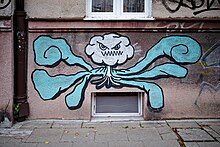
Since the collapse of communism in 1989, street art became prevalent inPolandthroughout the 1990s. Artists like Sainer and Bezt became known for painting huge murals on buildings and walls in the 2010s.[116]In the city ofŁódźa permanent city exhibition was financed in 2011, under the patronage of Mayor Hanna Zdanowska, called "Urban Forms Gallery".[117]The exhibition included work from some of Poland's elite street artists as well as globally known artists. Despite being mostly accepted by the public, with authorities occasionally allowing artists licenses to decorate public places, other properties are still illegally targeted by artists.WarsawandGdańskare other Polish cities with a vibrant street art culture.[118]
A monument inBulgariadepicting Soviet Army soldiers was targeted by anonymous street artists in June 2011. The soldiers of the monument, located inSofia,were embellished to portrayRonald McDonald,Santa Claus,Superman,and others. The monument existed in that condition for several days before being cleaned. Some citizens were in favor of allowing the embellishments to remain.[citation needed]
MariupolinUkrainesaw building murals playing a symbolic role in the 2014 and2022 Russian invasions of Ukraine.In 2018, the Ukrainian artistSasha Korbanpainted the muralMilanaon a facade of a Mariupol building, showing 3-year-old Milana Abdurashytova, a survivor of a 2015 pro-Russian missile attack, as a symbol of resilience.[119][120]The mural was destroyed in late 2022 while Mariupol was still occupied by Russian forces.[121]Also in 2022, the Italian artistJoritpainted a mural of a young Australian girl, found in an online search for the word "pigtails", on another building facade in Mariupol, initially stating that the subject was a girl fromDonbaswho had lived in Mariupol. His inclusion in the mural of a bomb labelled "NATO" in a town that was severely bombed by Russian forces and the relation with Korban's destroyed mural were criticised by media includingIl Giornaleand the investigative journalism websiteValigia Blu.[122][120][123]
Moscowbecame a hub forRussian graffiti artistsas well as international visitors in the 2000s. The Street Kit Gallery, opened in 2008, is dedicated to street art and organizes events in galleries, pop-up spaces and on the streets of the city. The 2009 Moscow International Biennale for Young Art included a section for street art. Active artists include Make, RUS, andKyiv-based Interesni Kazki (also active in Miami and Los Angeles).[124]Britain'sBBCnetwork highlighted the artwork of Moscow street artistPavel 183in 2012.[125][126]
The dissolution of the Soviet Union leftGeorgiawith tantalizing urban space for the development of street art. Although it is a relatively new trend in Georgia, the popularity of street art is growing rapidly. The majority of Georgian street artists are concentrated inTbilisi.Street art serves as a strong tool among young artists to protest against the many controversial issues in the social and political life in Georgia and thus gets considerable attention in society. Influential artists includeGagosh,TamOonz, and Dr.Love.[126][127][128]
Sarajevobecame a major hub for street art in Southeastern Europe in the 2010s. It hosts theSarajevo Street Art Festivaland the acclaimed 3D street art festival,Beton Fest.The former is held in July of every year and lasts for three days. Each year's edition is made up of numerous street performances, the creation of a new street arts bohemian quarter in the city, concerts, the painting of large murals and the showcasing of other creative art forms. The latter is the only 3D street art festival in Southeastern Europe[129]and has hosted many renowned street artists such as Vera Bugatti,[130]Giovanna la Pietra,[131]Tony Cuboliquido,[132]Manuel Bastante[133]and others.
-
Street art by WATTTS inParis,France
-
Painting in the Global TraditionbyCes53,a Dutch street artist
-
Street art inSesimbra,Portugal
-
Graphic-Domain inHeidelberg,Germany, by Nicola Pragera
-
Mural by BLU,Gaza Strip,Prague,Czech Republic
-
Graffiti inShoreditch,London, by Stik
-
Urban art inKatowice,Poland
-
Street art in the old city ofPrizren,Kosovo
-
"Geometrical boundaries of Time", street art inTbilisi,Georgia
-
Paste-up of El Bocho inHamburg,Germany
-
Graffiti on road,Latvia
-
Unicorn made of waste by Portuguese street artist Artur Bordalo (BordaloII) at NuArt Festival Aberdeen (2018)
Asia[edit]
India[edit]

InIndia,street art is hugely popular. Many of the film and TV series promotional materials were created by street painters/artists. Currently, digital art is replacing hand painted posters. From 1960 to the 1990s, the street posters worked well and impressed audiences. In the 1990s the hand painted posters started to be replaced by flex banners outside theatres. After the 2000s, the popularity of street posters started to decline, being replaced by digitally printed posters. Street artpaintingand street art drawingsketchhas since declined inIndiadue to the replacement by digital posters.
Malaysia[edit]
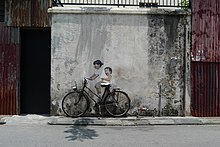
InGeorge Town,Penang, Lithuanian artistErnest Zachareviccreated a series of wall murals depicting local culture, inhabitants and lifestyles.[134]They now stand as celebrated cultural landmarks of George Town, withChildren on a Bicyclebecoming one of the most photographed spots in the city.[135]Since then, the street art scene has blossomed.
South Korea[edit]
InSouth Korea's second-largest city,Busan,German painter Hendrik Beikirch created a mural over 70 metres (230 ft) high, considered Asia's tallest at the time of its creation in August 2012. The monochromatic mural portrays a fisherman.[136]It was organized byPublic Delivery.[137]
Thailand[edit]
A great deal of street art by well-known artists can be found in theBang Rakdistrict of Bangkok, on Soi Charoen Krung 28-32, betweenCharoen Krungroad and theChao Phrayariver.[138]
United Arab Emirates[edit]
InUnited Arab Emirates' largest city,Dubai,several famous painters created urban mural artwork on the buildings, which was initiated by StreetArtNews and named it Dubai Street Museum.[139][140]
Oceania[edit]
Australia[edit]
There is street art in major cities as well as regional towns in Australia.[141]

Melbourneis home to one of the world's most active and diverse street art cultures and is home to pioneers in the stencil medium. Street artists such asBlek le RatandBanksyoften exhibited works on Melbourne's streets in the 2000s (decade). Works are supported and preserved by local councils. Key locations within the city includeBrunswick,Carlton,Fitzroy,Northcoteand thecity centreincluding the famousHosier Lane.[citation needed]
Sydney's street art scene includesNewtown area graffiti and street art.
New Zealand[edit]

Dunedinpioneered "official" street art in New Zealand with over sixty bus shelters being given unique murals by painter John Noakes during the 1980s, many of them featuring local scenes or scenes inspired by the names of their locales.[142]The Dunedin City Council has since commissioned a series of similar designs to grace electric boxes around the city. Street murals have also become a popular addition to Dunedin, with over 30 works by both local and overseas artists being added to the central city—especially around theWarehouse PrecinctandExchangeareas—since an international street art festival was held there in the early 2000s.[143]These include one of New Zealand's tallest works, a seven-story mural on the wall of theSouthern Cross Hotelby Fintan Magee.[144]
Christchurchwas devastated by2 earthquakes in 2010 and 2011and as a result, 8000 homes and 80 percent of the central city were condemned. It wasn't until two and half years later that the city was able to host its first major cultural event[citation needed]-Rise Street Art Festivalheld atCanterbury Museumproduced by Australasian street art organizer Oi YOU!.[145]
The event attracted over 248,000 visitors (the most-visited show in the museum's history) and saw 15 murals painted across the devastated central city. The murals became community icons for the re-emergence and rebuild of Christchurch.[citation needed]
Two further Oi YOU! Festivals, both under the name ofSpectrum,featured large internal exhibitions as well as adding to the city's stock of murals.[146]SinceRise,over 40 murals have been produced in the central city and theLonely Planetguide to global street art featured Christchurch as one of the best cities in the world to experience the art form.[citation needed]
InAucklandin 2009, Auckland's city council permitted electrical boxes to be used as canvases for street art. Local street art groupTMD(The Most Dedicated) won the "Write For Gold" international competition in Germany two years in a row. Surplus Bargains is another local collective.[147]In 2019 in Auckland, a heritage building in the city was painted without the owners' permission by Ares Artifex.[148]
Africa[edit]
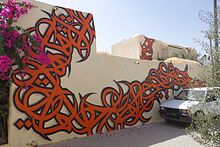
Although street art inSouth Africais not as ubiquitous as in European cities,Johannesburg's centralNewtowndistrict is a center for street art in the city.[149]The "City Of Gold International Urban Art Festival" was held in the city'sBraamfonteincivic and student district in April 2012.[150]
TheNew York TimesreportedCairo's emergence as a street art center of the region in 2011. Slogans calling for the overthrow of theMubarakregime has evolved into æsthetic and politically provocative motifs.[151][152]
Street art fromEgypt,Tunisia,Yemen,andLibyahas gained notoriety since theArab Spring,including a 2012 exhibition inMadrid's Casa Árabe.[153]
Exhibitions, festivals and conferences[edit]
In 1981,Washington Project for the Artsheld an exhibition entitledStreet Works,which includedurban artpioneers such asFab Five FreddyandLee Quiñonesworking directly on the streets.[154]
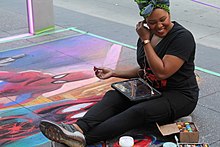
Sarasota Chalk Festivalwas founded in 2007 sponsoring street art by artists initially invited from throughout the US and soon extended to internationally. In 2011 the festival introduced aGoing Verticalmural program and itsCellographproject to accompany the street drawings that also are created by renowned artists from around the world. Many international films have been produced by and about artists who have participated in the programs, their murals and street drawings, and special events at the festival.[156]
TheStreetart Festival Istanbulis Turkey's first annual street art and post-graffiti festival.[157]The Festival was founded by the artist and graphics designer Pertev Emre Tastaban in 2007.[158]

Living Wallsis an annual street art conference founded in 2009.[159]In 2010 it was hosted inAtlantaand in 2011 jointly in Atlanta andAlbany,New York. Living Walls was also active in promoting street art atArt Basel Miami Beach2011.[160]
The RVA Street Art Festival is a street art festival inRichmond,Virginia, began in 2012. It is organized by Edward Trask and Jon Baliles. In 2012, the festival took place along the Canal Walk; in 2013 it took place at the abandoned GRTC lot on Cary Street.[161]
ThePasadena Chalk Festival,held annually inPasadena,California, is the largest street-art festival in the world, according toGuinness World Records.[162]The 2010 edition involved about six hundred artists of all ages and skills and attracted more than 100,000 visitors.[163]
UMA - Universal Museum of Art[164]launched a comprehensive Street Art exhibition "A Walk Into Street Art"[165]in April 2018. This exhibition in virtual reality offers works fromBanksy,JR,Jef Aérosol,Vhils,Shepard Fairey,Keith Haring,among others.
The Eureka Street Art Festival is an annual public art event inHumboldt County,California. Artists from throughout California and the world to paint murals and create street art during a week-long festival. The 2018 festival saw 24 artists create 22 pieces of public art in the Old Town area of the city, focusing on Opera Alley.[166]The 2019 festival is centered on the Downtown region.
Documentary films[edit]
- Rash(2005), a feature-length documentary by Mutiny Media exploring the cultural value of Australian street art and graffiti
- Bomb It(2008), a documentary film about graffiti and street art around the world
- Exit Through the Gift Shop(2010), a documentary created by the artistBanksyaboutThierry Guetta
- Style Wars(1983), a PBS documentary about graffiti artists in New York City featuringSeen,Kase2,DezandDondi
- Obey Giant(2017), a documentary about the life and career of street artist, illustrator, graphic designer, activist, and founder ofOBEY Clothing,Shepard Fairey.
See also[edit]
- Brandalism
- Contemporary art
- Craftivism
- Eyesaw
- Father Pat Noise
- Graffiti
- Graffiti terminology
- Graphopoli
- Guerilla art and hacking art (category)
- List of street artists
- Lock On street art
- Mission School
- Overspray Magazine
- Public art
- Rock balancing
- Screen-printing
- Spray paint art
- Stencil
- Street art in Israel
- Street installation
- Street poster art
- Tower 13
- USB dead drop
- Yarn bombing
References[edit]
- ^"Autour du Panthéon, la chasse aux portraits est ouverte!"Archived3 October 2021 at theWayback Machine,BeauxArts(in French), 11 July 2018
- ^Brooks, Raillan (6 December 2013)."Aerosol Art".The New York Times.ISSN0362-4331.Archivedfrom the original on 27 November 2020.Retrieved16 October2022.
- ^Antonova, Maria. 2014. "Street Art." Russian Life 57(5):17
- ^"Student art project is vandalism for a cause".The Herald-Times.Archived fromthe originalon 20 March 2012.Retrieved4 April2011.
- ^For the development of style in the aerosol paint medium, as well as an examination of the political, cultural, and social commentary of its artists, see the anthropological history of New York subway graffiti art,Getting Up: Subway Graffiti in New York,by Craig Castleman, a student ofMargaret Mead,The MIT Press, Cambridge, Massachusetts, 1982.
- ^Geek Graffiti: A Study in Computation, Gesture and Graffiti Analysis
- ^ab Smith, Howard (21 December 1982). "Apple of Temptation".The Village Voice.Manhattan, New York, US. p. 38.
- ^Zotti, Ed (4 August 2000)."What's the origin of 'Kilroy was here'?".Straight Dope; staff report from the Science Advisory Board.Sun-Times Media, LLC.Archivedfrom the original on 5 January 2020.Retrieved29 October2016.
- ^Robinson, David (1990)Soho Walls – Beyond Graffiti,Thames & Hudson, NY,ISBN978-0-500-27602-0
- ^Drasher, Katherine (30 June 1983)."Avant's on the Street".The Villager.pp. 31–32.Archivedfrom the original on 7 July 2011.Retrieved29 August2009.
- ^abZox-Weaver, Annalisa (1 June 2015). "Institutional Guerilla Art Open Access: The Public Sculpture of Florentijn Hofman".Sculpture Review.3(22–26).
- ^Tierney, John (6 November 1990)."A Wall in SoHo; Enter 2 Artists, Feuding".The New York Times.ISSN0362-4331.OCLC1645522.Archivedfrom the original on 18 October 2014.Retrieved4 May2012.
- ^ab Strausbaugh, John (5–11 April 1995). "Reneissance Man".New York Press.Vol. 8, no. 14. p. Cover, 15, 16.ISSN0362-4331.OCLC1645522.
- ^"Moncada v. Rubin-Spangle Gallery, Inc. – November 4, 1993".Leagle.com. 4 November 1993.Archivedfrom the original on 26 April 2015.Retrieved29 April2012.
- ^ Landes, William M.; Posner, Richard A. (2003).The Economic Structure of Intellectual Property Law(illustrated ed.). Cambridge, Massachusetts, US:Harvard University Press.p. 285.ISBN978-0-674-01204-2.OCLC52208762.Retrieved4 May2012.
- ^ Ginsburgh, Victor; Throsby, C. D. (13 November 2006).Handbook of the Economics of Art and Culture(illustrated, reprint ed.). Amsterdam, Netherlands:Elsevier.p. 231.ISBN978-0-444-50870-6.OCLC774660408.Retrieved4 May2012.
- ^ Lerner, Ralph E.; Bresler, Judith (2005).Art law: the guide for collectors, investors, dealers, and artists(3rd ed.). New York City, New York, US:Practising Law Institute.ISBN978-1-4024-0650-8.OCLC62207673.Retrieved4 May2012.
- ^ Kostelanetz, Richard (2003).SoHo; The Rise and Fall of an Artist's Colony(1st ed.). New York, NY: Routledge. pp.102–104.ISBN978-0-415-96572-9.Retrieved29 October2016.
- ^ Kahn, Steve (1999).SoHo New York.New York, NY: Rizzoli International Publications, Inc. p.65.ISBN978-0-8478-2156-3.
- ^ I AM THE BEST ARTIST Renemural (1987).The Secret of My Success(Comedy film). US: Universal Studios.
- ^ Glassman, Carl (1985).SoHo; A Picture Portrait.New York, NY: Universe Books. pp. TK.ISBN978-0-87663-566-7.
- ^"Home".francothegreat.com.Archivedfrom the original on 16 March 2022.Retrieved24 March2022.
- ^"Incredible street art tours".Archivedfrom the original on 17 November 2015.Retrieved26 February2015.
- ^Means, Gary."Alternative London Street Art Guides".alternativeldn.com.Archived fromthe originalon 4 January 2018.Retrieved26 February2015.
- ^"Paris Underground".undergroundparis.org.Archived fromthe originalon 31 March 2022.Retrieved26 February2015.
- ^"Alternative Berlin".alternativeberlin.com.Archived fromthe originalon 11 November 2011.Retrieved26 February2015.
- ^Bross, F. (2017):Beer Prices Correlate with the Quality of Illegal Urban Art. A Case Study on the Relationship Between Street Art and Gentrification in a Berlin NeighborhoodArchived30 July 2017 at theWayback Machine.Mimeo.
- ^Salib, Peter (Fall 2015). "The Law of Banksy: Who Owns Street Art?".University of Chicago Law Review.82(4): 293.SSRN2711789.
- ^17 U.S.C. § 102
- ^17 U.S. Code § 302
- ^17 U.S. Code § 201
- ^"moral, adj.". OED Online. September 2011. Oxford University Press. 25 October 2011.
- ^Voon, Claire (15 March 2018)."H&M Lawsuit Against Street Artist Could Change Copyright Law".Hyperallergic.Archivedfrom the original on 6 October 2022.Retrieved16 October2022.
- ^Villa, 2003 WL 22922178
- ^Graffiti Cannot be Copyright Protected, Claims Moschino, Jeremy Scott. (2016). The Fashion Law. Retrieved 29 April 2019, fromhttp://www.thefashionlaw.com/home/graffiti-cannot-be-copyright-protected-claims-moschino-jeremy-scottArchived1 March 2019 at theWayback Machine
- ^abId.
- ^17 U.S.C. § 106A
- ^"Unchartered Territory: Enforcing an Artist's Rights in Street Art".HHR Art Law.11 January 2017.Archivedfrom the original on 27 September 2020.Retrieved16 October2022.
- ^Finn, Robin (27 August 2011)."Writing's on the Wall (Art Is, Too, for Now)".The New York Times.ISSN0362-4331.Archivedfrom the original on 15 December 2018.Retrieved16 October2022.
- ^abcBloch, Stefano. 2015. "Street Art, Public City: Law, Crime and the Urban Imagination." Urban Studies (Sage Publications, Ltd.) 52(13):2500-2503.
- ^Campos, Ricardo. 2015. "Youth, Graffiti, and the Aestheticization of Transgression." Social Analysis 59(3):17-40.
- ^abcdefBacharach, Sondra (4 January 2016)."Street Art and Consent".British Journal of Aesthetics.55(4): 481–495.doi:10.1093/aesthj/ayv030.Archivedfrom the original on 22 January 2022.Retrieved22 January2022.
- ^abcdeSisko (Summer 2015). "Guerilla Sculpture: Free Speech and Dissent".Sculpture Review.64(2): 26–35.
- ^The Journal of Aesthetics and Art Criticism, 68:3, summer 2010
- ^The Contested Gallery: Street Art, Ethnography and the Search for Urban Understandings, AmeriQuest Vol. 2 nr. 1, 2005
- ^"'Hope flows through her': artist Marc Quinn on replacing Colston with a Black Lives Matter statue ".the Guardian.15 July 2020.Archivedfrom the original on 11 February 2021.Retrieved10 February2021.
- ^"Jen Reid: Bristol Black Lives Matter statue removed".BBC News.16 July 2020.Archivedfrom the original on 16 July 2020.Retrieved10 February2021.
- ^abInfoactivismo (30 October 2017)."Antimonumentos: intervenciones, arte, memoria | InfoActivismo.org"(in Spanish).Archivedfrom the original on 27 October 2021.Retrieved13 October2021.
- ^Seligmann-Silva, Márcio (January–April 2016)."Antimonumentos: trabalho de memória e de resistência".Psicologia USP(in Portuguese).27:49–60.doi:10.1590/0103-6564D20150011.ISSN0103-6564.
- ^"Por qué están apareciendo" antimonumentos "en México (y cómo reflejan los episodios más oscuros de su historia reciente)".BBC News Mundo(in Spanish).Archivedfrom the original on 28 October 2021.Retrieved13 October2021.
- ^Steinmetz, Jesse (28 April 2023)."From slams to sidewalks, poetry is alive in Greater Boston".WGBH News.Archivedfrom the original on 10 May 2023.Retrieved31 May2023.
- ^Brooks, Jennifer (31 May 2023)."The sidewalk poetry of St. Paul writes a city's story underfoot".Star Tribune.Retrieved31 May2023.
- ^Bhasin, Punya (4 September 2022)."Oakland's First Sidewalk Poetry Contest Celebrates Its History and Future".Pittsburgh Magazine.Archivedfrom the original on 3 February 2023.Retrieved31 May2023.
- ^ITV News (10 December 2021)."Banksy and other street art goes on display at Peterborough Museum".ITV.Archivedfrom the original on 10 January 2022.Retrieved10 January2022.
- ^C. Gogarty and D. Clensy (28 March 2019)."A look back at when Banksy took over Bristol Museum in 2009".Bristol Post.Archivedfrom the original on 11 January 2022.Retrieved10 January2022.
- ^Guetzkow 2002, Joshua."The World is Our Canvas: Nonprofit Empowers Street Artists to Uplift Neighborhoods"(PDF).Archived(PDF)from the original on 9 March 2018.Retrieved3 January2019.
{{cite journal}}:Cite journal requires|journal=(help)CS1 maint: numeric names: authors list (link) - ^Crouch, Angie."How the Arts Impact Communities".NBC. NBC Los Angeles.Archivedfrom the original on 3 January 2019.Retrieved3 January2019.
- ^Sydney Page (8 June 2022)."Art painted on crosswalks makes streets safer, group says".The Washington PostUnited States.Archivedfrom the original on 5 February 2023.Retrieved8 June2022.
- ^"Under Pressure – Annual Graffiti Festival".underpressure.ca.Archivedfrom the original on 23 February 2021.Retrieved16 January2021.
- ^"Toronto Graffiti:: urban artists for hire".Archivedfrom the original on 20 January 2021.Retrieved29 July2015.
- ^"Home".yycbump.ca.Archivedfrom the original on 27 February 2020.Retrieved27 February2020.
- ^Rojo, Jaime; Harrington, Steven P. (2010).Street Art New York.Prestel Pub.ISBN978-3-7913-4428-7.
- ^Kugel, Seth (9 March 2008)."To the Trained Eye, Museum Pieces Lurk Everywhere".The New York Times.ISSN0362-4331.Archivedfrom the original on 11 April 2019.Retrieved16 October2022.
- ^"History | Mural Arts Program".Muralarts.org.Archivedfrom the original on 10 September 2017.Retrieved7 July2012.
- ^Hoff, Al (14 December 2006)."Best Public Art: Sprout Fund Murals".Pittsburgh City Paper.Archivedfrom the original on 26 January 2021.Retrieved2 April2013.
- ^Wheatley, Thomas (5 May 2011)."Atlanta's graffiti task force begins investigating, removing vandalism & Views".Clatl.com.Archivedfrom the original on 4 April 2016.Retrieved7 July2012.
- ^Morris, Mike (4 October 2011)."Warrants issued for serial graffiti vandals".ajc.com.Archived fromthe originalon 7 January 2012.Retrieved7 July2012.
- ^"City of Atlanta settles lawsuit with street artists | Bill Rankin's Legal Brief".Archived fromthe originalon 12 February 2018.Retrieved11 February2018.
- ^"New website provides street art map to murals all over Atlanta".accessatlanta.Archived fromthe originalon 15 January 2018.Retrieved5 January2018.
- ^Smith, Jessi,Get a ringside seat: MTO is not pulling any punches in his latest muralArchived1 October 2013 at theWayback Machine,This Week in Sarasota, 20 December 2012
- ^"An 'Unpremeditated Cultural Clash'".HuffPost.20 March 2013.Archivedfrom the original on 16 October 2022.Retrieved16 October2022.
- ^Graham, Jefferson (1 June 2018)."Photo tour: Graffiti steals the show in L.A.'s burgeoning Arts District".USA Today.Archivedfrom the original on 5 December 2019.Retrieved4 December2019.
- ^Larson, Nicole (13 May 2011)."PHOTOS: Largest Street Art Collection Debuts At LAB ART LA".The Huffington Post.Archivedfrom the original on 5 April 2016.Retrieved18 February2020.
- ^San Francisco Bay Guardian, 18–24 January 2012, p. 22
- ^Veltman, Chloe (9 May 2010)."Street Art Moves Onto Some New Streets".The New York Times.ISSN0362-4331.Archivedfrom the original on 26 April 2017.Retrieved16 October2022.
- ^Karlamangla, Soumya (19 April 2022)."San Diego's Chicano Park Celebrates Its Anniversary".The New York Times.ISSN0362-4331.Archivedfrom the original on 18 October 2022.Retrieved18 October2022.
- ^Mendoza, Alexandra (19 December 2021)."San Diego, Tijuana artists honor Mexican icon Vicente Fernández with murals".San Diego Union-Tribune.Archivedfrom the original on 18 October 2022.Retrieved18 October2022.
- ^Mendoza, Alexandra (2 October 2021)."Mural celebra al Canelo, Pacquiao y al fundador de un gimnasio de boxeo en San Diego".Los Angeles Times en Español(in Spanish).Archivedfrom the original on 18 October 2022.Retrieved18 October2022.
- ^Alverez, Elizabeth (18 November 2020)."New mural of Padres legend Tony Gwynn completed in City Heights -".McKinnon Broadcasting.Archivedfrom the original on 18 October 2022.Retrieved18 October2022.
- ^"The Unknown, Underrated Street Art of Richmond, Virginia (Photo Essay)".Packs Light.19 January 2016.Archivedfrom the original on 12 April 2017.Retrieved11 April2017.
- ^"The Best Denver Street Art | VISIT DENVER".www.denver.org.Archivedfrom the original on 22 April 2017.Retrieved21 April2017.
- ^"About".6 June 2018.Archivedfrom the original on 18 December 2019.Retrieved11 December2019.
- ^"Bier en Brod create new mural for All City Canvas".4 December 2019.Archivedfrom the original on 11 December 2019.Retrieved11 December2019.
- ^"Vhils leaves amazing mural in Parque la Ruina for All City Canvas Global Series".9 December 2019.Archivedfrom the original on 12 December 2019.Retrieved11 December2019.
- ^"Colorful mural might be world's longest".Reuters.Archived fromthe originalon 12 August 2018.Retrieved4 November2015.
- ^Romero, Simon (29 January 2012)"At War With São Paulo's Establishment, Black Paint in Hand"Archived1 May 2017 at theWayback Machine,The New York Times
- ^Scott, Gabe (17 July 2009)."Claudio Ethos".Exclusive Feature.High Speed Productions, Inc.Archivedfrom the original on 23 January 2018.Retrieved29 October2016.
- ^"Distrito graffiti (graffiti district)".Archivedfrom the original on 18 May 2022.Retrieved30 March2022.
- ^"The Banksy Paradox: 7 Sides to the World's Most Infamous Street ArtistArchived2 April 2011 at theWayback Machine,19 July 2007
- ^"Walking with Stik".Dulwich OnView,UK.12 June 2012.Archivedfrom the original on 21 October 2016.Retrieved17 June2012.
- ^Beazley, Ingrid(2015).Street Art, Fine Art.London: Heni Publishing.ISBN978-0-9568738-5-9.
- ^"Has Banksy struck in Primrose Hill?".BBC News.11 June 2010.Archivedfrom the original on 29 November 2019.Retrieved2 April2013.
- ^"10 Stencil Artists Changing the Way We Look at the City".My Modern Met.22 May 2017.Archivedfrom the original on 10 July 2018.Retrieved10 July2018.
- ^"Street Art in 13 Arrondissement".Paris Digest. 2018.Archivedfrom the original on 22 October 2018.Retrieved22 October2018.
- ^"IMMENSE SUCCES POUR L'EXPOSITION AVEC 113 228 VISITEURS!"[Great success for the exhibition with 113,228 visitors!](PDF)(Press release) (in French). Paris: Fondation EDF. 2 March 2015.Archived(PDF)from the original on 30 December 2018.Retrieved30 December2018.
- ^Barba-Court, Kala (18 May 2018)."John Hamon: The Enigmatic, Enduring Mystery Of Paris".Plain Magazine.Archivedfrom the original on 20 May 2019.Retrieved20 May2019.
- ^Lepores, Domingos (13 September 2017)."Berlin Street Art Museum - Urban Nation Contemporary Urban Art".AWESOME BERLIN.Archived fromthe originalon 15 January 2020.Retrieved15 January2020.
- ^Karsten Kaminski."Tänavakunst Tartus: rohkem kui ainult kunst"Archived23 April 2016 at theWayback MachinePostimees Kultuur, 26 April 2015 [in Estonian]
- ^Marika Agu & Sirla.Street art in Tartu, EstoniaArchived21 April 2016 at theWayback MachineVandalog, 8 July 2014
- ^Donadio, Rachel (14 October 2011)."In Athens art blossoms amid debt crisis".The New York Times.Archivedfrom the original on 23 May 2013.Retrieved14 October2011.
- ^Stewart, Jessica (1 January 2013).Street Art Stories Roma.Mondo Bizzarro. p. 128.ISBN978-8896850152.
- ^15 Dutch Street Artists you must KnownArchived12 November 2019 at theWayback Machine,Street Art Today
- ^"Dr. Rat, Godfather van de Nederlandse graffiti".Lebowski.Archivedfrom the original on 27 September 2020.Retrieved5 April2014.
- ^Malt, Frank (2014). 100 European graffiti artists. Atglen, Pennsylvania, Schiffer Publisching Ltd.
- ^Ødegård, Ann Kristin (24 March 2010)."Gatekunstens hovedstad"(in Norwegian). Ba.no.Archivedfrom the original on 14 October 2014.Retrieved24 March2010.
- ^Thorkildsen, Joakim (10 March 2008)."Fikk Banksy-bilder som takk for overnatting"(in Norwegian). Dagbladet.no. Archived fromthe originalon 13 March 2017.Retrieved16 September2012.
- ^"Derfor valgte ikke DOLK Bergen"(in Norwegian). Ba.no. 8 September 2011.Archivedfrom the original on 14 October 2014.Retrieved18 September2011.
- ^Bergesen, Guro H."Populær Dolk selger så det suser"(in Norwegian). Bt.no. Archived fromthe originalon 19 December 2014.Retrieved21 September2011.
- ^"Forsvarer verning av graffiti"(in Norwegian). Ba.no. 26 June 2009.Archivedfrom the original on 14 October 2014.Retrieved26 June2009.
- ^"Bergenkommune.no – Graffiti og gatekunst i kulturbyen Bergen – Utredning og handlingsplan for perioden 2011–2015"(PDF)(in Norwegian). Bergen.kommune.no. Archived fromthe original(PDF)on 21 July 2013.Retrieved10 May2011.
- ^"Home".nuartrad.no.Archivedfrom the original on 13 August 2022.Retrieved8 August2022.
- ^Carlsson, Benke (2007).Street art Stockholm.Stockholm: Ström.ISBN9789171260765.
- ^Gallery housing mentioned street artistsArchived20 November 2013 at theWayback Machine
- ^Billeter, F. (1984).Graffiti: Wandkunst und wilde Bilder.Basel: Birkhäuser.ISBN978-3-7643-1617-4.
- ^"Ata Bozaci".Widewalls.Archivedfrom the original on 16 March 2018.Retrieved15 March2018.
- ^"Huge murals on buildings created by artist duo ETAM CRU".NetDost.16 January 2014. Archived fromthe originalon 20 January 2014.
- ^Eugene (29 September 2011)."Polish City Embraces Street Art – My Modern Metropolis".Mymodernmet.com.Archivedfrom the original on 4 March 2016.Retrieved7 July2012.
- ^"Poland – Street-art and Graffiti".FatCap.Archivedfrom the original on 26 February 2021.Retrieved7 July2012.
- ^Mural project,Rinat Akhmetov Foundation,c. 2018,WikidataQ120793915,archivedfrom the original on 21 July 2023
- ^abLorenzo Tondo (19 July 2023)."Photographer says street artist used daughter's picture in pro-Russia mural".The Guardian.ISSN0261-3077.WikidataQ120786372.Archivedfrom the original on 20 July 2023.
- ^Russian invaders destroyed a mural with a girl who lost her mother during the shelling of Mariupol in 2015,We are Ukraine, 2022,WikidataQ120794455,archivedfrom the original on 22 July 2023
- ^Leonardo Bianchi (15 July 2023),Il vergognoso murale di Jorit a Mariupol[Jorit's disgraceful mural in Mariupol] (in Italian), Valigia Blu,WikidataQ120788862,archivedfrom the original on 21 July 2023
- ^Angelo Allegri (14 July 2023)."Jorit, il graffitaro finanziato dalla Campania che dipinge murales per gli occupanti russi"[Jorit, the graffiti artist funded by Campania who paints murals for Russian occupants].Il Giornale(in Italian).ISSN1124-8831.WikidataQ120791946.Archivedfrom the original on 21 July 2023.
- ^Pfeiffer, Alice (13 October 2010)."Alice Pfeiffer," Graffiti Art Earns New Respect in Moscow ",New York Times,13 October 2010 ".The New York Times.Archivedfrom the original on 22 April 2017.Retrieved18 February2017.
- ^"Street artist 'Russia's answer to Bansky'".BBC. 8 February 2012.Archivedfrom the original on 4 July 2012.Retrieved21 June2012.
- ^abDocumentary film about street art in Tbilisi by KetevanVashagashvili. "Gallery in the Street", 17 May 2015[1]Archived24 March 2016 at theWayback MachineRetrieved on 12 November 2015
- ^Caucasus Business Week www.cbw.ge "Amazing Street-Art of Georgia", 9 March 2015[2]Archived23 November 2015 at theWayback MachineRetrieved on 9 November 2015
- ^Georgia Today. Nina Ioseliani. www.georgiatoday.ge "Street art in Georgia", 20 August 2015[3]Archived13 December 2015 at theWayback MachineRetrieved on 27 August 2015
- ^"Beton Fest čini Sarajevo 3D prijestlonicom svijeta".N1 Television.Archivedfrom the original on 14 June 2018.Retrieved18 April2018.
- ^"3D street art on Peace in Sarajevo".verabugatti.it.Archivedfrom the original on 22 October 2020.Retrieved18 April2018.
- ^"Cijelo Sarajevo pozvano na Beton Fest".klix.ba.Archivedfrom the original on 14 June 2018.Retrieved18 April2018.
- ^"3D street painting festival in Sarajevo".cuboliquido.com.Archivedfrom the original on 10 September 2019.Retrieved18 April2018.
- ^"Sarajevo: Još samo pet dana do četvrtog Beton Festa".Radio Sarajevo. 21 August 2015.Archivedfrom the original on 17 June 2018.Retrieved18 April2018.
- ^Lim, Serene (24 April 2015)."The good, bad and ugly of street artist Ernest Zacharevic's murals".Today.Archivedfrom the original on 27 April 2015.Retrieved26 April2015.
- ^Winnie Yeoh (3 November 2013)."The Guardian picks Little Children".The Star.Archivedfrom the original on 1 May 2022.Retrieved1 May2022.
- ^"Asia's Tallest Mural in South Korea by Hendrik Beikirch".7 September 2012.Archivedfrom the original on 13 August 2020.Retrieved8 July2013.
- ^"Asia's tallest mural – By Hendrik Beikirch".5 September 2012.Archivedfrom the original on 27 February 2021.Retrieved29 July2015.
- ^"Street Art, Charoen Krung Road".www.tourismthailand.org.Retrieved17 January2024.
- ^Winks, Mathias (14 December 2016).""Curiosity" - New Mural by Street Artist Seth Globepainter in Dubai // UAE ".MC Winkels weBlog(in German).Archivedfrom the original on 15 January 2020.Retrieved15 January2020.
- ^McFarlane, Nyree (29 November 2016)."Satwa is currently turning into a huge street art gallery".What's On.Archivedfrom the original on 15 January 2020.Retrieved15 January2020.
- ^"Australian Street Art Towns".Australian Silo Art Trail.20 May 2021.Retrieved23 May2021.
- ^"Tribute to bus shelter artist unveiledArchived30 November 2018 at theWayback Machine,"Otago Daily Times,17 April 2012. Retrieved 1 December 2018.
- ^"ArtworksArchived22 November 2018 at theWayback Machine,"dunedinstreetart.co Retrieved 1 December 2018.
- ^This was New Zealand's tallest street mural until the creation of a nine-storey mural inInvercargillin 2019.
- ^"Rise Street Art Christchurch | Oi YOU!".Archivedfrom the original on 25 April 2017.Retrieved19 June2017.
- ^"Spectrum Street Art Christchurch 2015".Archivedfrom the original on 30 September 2017.Retrieved19 June2017.
- ^Allen, Linlee. (9 November 2009)Linlee Allen, "Street Smart | Auckland's Art Bandits"Archived18 December 2019 at theWayback Machine,The New York Times.Tmagazine.blogs.nytimes.com. Retrieved 2 April 2013.
- ^"Massive mural".Newshub.Archivedfrom the original on 27 February 2020.Retrieved11 July2019.
- ^"Report graffiti hotspots", City of Johannesburg site, 28 June 2012Archived11 July 2012 at theWayback Machine
- ^"South Africa: Hotel, Graffiti Crew Partner to Host Art Festival", AllAfrica.com, 16 April 2012Archived31 March 2013 at theWayback Machine.Allafrica.com (16 April 2012). Retrieved 2 April 2013.
- ^Wood, Josh (27 July 2011)"The Maturing of Street Art in Cairo"Archived11 April 2022 at theWayback Machine,The New York Times.
- ^"The Best Of Egyptian Political Street Art"Archived10 July 2013 at theWayback Machine.Retrieved 4 July 2013.
- ^Duggan, Grace. (2 February 2012)"Arab Spring Street Art, on View in Madrid"Archived28 October 2020 at theWayback Machine,The New York Times.
- ^Lewisohn, Cedar (2008)Street Art: The Graffiti Revolution,Tate Gallery,London, England,ISBN978-1-85437-767-8.
- ^"Amanda Lee Harris".Downtown Minneapolis Street Art Festival.Archivedfrom the original on 17 August 2019.Retrieved17 August2019.
- ^Chalk FestivalArchived2 November 2014 at theWayback Machine,a forty-page guide to the 2012 Sarasota Chalk Festival, Sarasota Observer, 28 October through 6 November 2012
- ^"404 | Go Turkey Tourism".Archivedfrom the original on 24 January 2013.Retrieved1 November2018.
{{cite web}}:Cite uses generic title (help) - ^carlenehempel (18 July 2011)."In Istanbul, artists take their ideas to the streets".NU Journalism Abroad 2011.Archivedfrom the original on 16 October 2022.Retrieved16 October2022.
- ^Guzner, Sonia (22 August 2011)."'Living Walls' Speaks Out Through Street Art ".The Emory Wheel.Archived fromthe originalon 29 July 2012.Retrieved9 January2012.
- ^"Living Walls".Archived fromthe originalon 10 July 2012.Retrieved29 July2015.
- ^"2013 RVA Street Art Festival to revitalize GRTC property".CBS6.20 March 2013.Archivedfrom the original on 22 September 2020.Retrieved22 May2013.
- ^"World's largest chalk art festival draws a crowd in Pasadena".Pasadena Star News.21 June 2015.Archivedfrom the original on 22 August 2016.Retrieved16 October2022.
- ^"Pasadena Chalk Festival called the world's largest street-art festival".Daily News.20 June 2010.Archivedfrom the original on 11 October 2016.Retrieved16 October2022.
- ^"UMA - Universal Museum of Art".Archived fromthe originalon 6 May 2013.Retrieved6 June2018.
- ^"A Walk Into Street Art".Archived fromthe originalon 12 June 2018.Retrieved6 June2018.
- ^Catsos, Jennifer."Past Festivals".Eureka Street Art Festival.Archivedfrom the original on 8 March 2019.Retrieved7 March2019.
Further reading[edit]
- Avramidis, Konstantinos, & Tsilimpounidi, Myrto (Eds.), (2017), "Graffiti and Street Art: Reading, Writing and Representing the City", Routledge,ISBN978-1472473332
- Bearman, Joshuah(1 October 2008)."Street Cred: Why would Barack Obama invite a graffiti artist with a long rap sheet to launch a guerrilla marketing campaign on his behalf?".Modern Painters.Archivedfrom the original on 24 October 2008.Retrieved1 October2008.
- Le Bijoutier (2008),This Means Nothing,Powerhouse Books,ISBN978-1-57687-417-2
- Bonadio, Enrico (2019).The Cambridge handbook of copyright in street art and graffiti.Cambridge, UK: Cambridge University Press.ISBN9781108563581.OCLC1130060776.
- Bou, Louis (2006),NYC BCN: Street Art Revolution,HarperCollins,ISBN978-0-06-121004-4
- Bou, Louis (2005),Street Art: Graffiti, stencils, stickers & logos,Instituto Monsa de ediciones, S.A.,ISBN978-84-96429-11-6
- Chaffee, Lyman (1993).Political Protest and Street Art: Popular Tools for Democratization in Hispanic Cultures.Westport, CT:Greenwood Press.ISBN978-0-313-28808-1.
- Combs, Dave and Holly (2008),PEEL: The Art of the Sticker,Mark Batty Publisher,ISBN0-9795546-0-8
- Danysz, Magda(2009)From Style Writing to Art, a street art anthology,Dokument Press,ISBN978-8-888-49352-7
- Fairey, Shepard(2008),Obey: E Pluribus Venom: The Art of Shepard Fairey,Gingko Press,ISBN978-1-58423-295-7
- Fairey, Shepard (2009),Obey: Supply & Demand, The Art of Shepard Fairey,Gingko Press,ISBN978-1-58423-349-7
- Gavin, Francesca (2007),Street Renegades: New Underground Art,Laurence King Publishers,ISBN978-1-85669-529-9
- Goldstein, Jerry (2008),Athens Street Art,Athens: Athens News,ISBN978-960-89200-6-4
- Harrington, Steven P. and Rojo, Jaime (2008),Brooklyn Street Art,Prestel,ISBN978-3-7913-3963-4
- Harrington, Steven P. and Rojo, Jaime (2010),Street Art New York,Prestel,ISBN978-3-7913-4428-7
- Hundertmark, Christian (2005),The Art Of Rebellion: The World Of Street Art,Gingko Press,ISBN978-1-58423-157-8
- Hundertmark, Christian (2006),The Art Of Rebellion 2: World of Urban Art Activism,Gingko Press,ISBN978-3-9809909-4-3
- Jakob, Kai (2009),Street Art in Berlin,Jaron,ISBN978-3-89773-596-5
- Longhi, Samantha (2007),Stencil History X,Association C215,ISBN978-2-9525682-2-7
- Manco, Tristan (2002),Stencil Graffiti,Thames and Hudson,ISBN0-500-28342-7
- Manco, Tristan (2004),Street Logos,Thames and Hudson,ISBN0-500-28469-5
- Marziani, Gianluca (2009),Scala Mercalli: The Creative Earthquake of Italian Street Art,Drago Publishing,ISBN978-88-88493-42-8
- Palmer, Rod (2008),Street Art Chile,Eight Books,ISBN978-0-9554322-1-7
- Rasch, Carsten (2014),Street Art: From around the World – stencil graffiti – wheatpasted poster art – sticker art – Volume I, Hamburg,ISBN978-3-73860-931-8
- Riggle, Nicholas Alden (2010), "Street Art: The Transfiguration of the Commonplaces," Journal of Aesthetics and Art Criticism, Vol. 68, Issue 3 (248–257).
- Robinson, David (1990)Soho Walls – Beyond Graffiti,Thames & Hudson, NY,ISBN978-0-500-27602-0
- Ross, Jeffrey Ian (Ed.), (2016), "Routledge Handbook of Graffiti and Street Art", Routledge,ISBN978-1138792937
- Schwartzman, Allan (1985),Street Art,The Dial Press,ISBN978-0-385-19950-6
- Strike, Christian and Rose, Aaron (August 2005),Beautiful Losers: Contemporary Art and Street Culture,Distributed Art Publishers,ISBN1-933045-30-2
- Walde, Claudia (2007),Sticker City: Paper Graffiti Art (Street Graphics / Street Art Series),Thames & Hudson,ISBN978-0-500-28668-5
- Walde, Claudia (2011),Street Fonts – Graffiti Alphabets From Around The World,Thames & Hudson,ISBN978-0-500-51559-4
- Williams, Sarah Jaye, ed. (2008),Philosophy of Obey (Obey Giant): The Formative Years (1989–2008),Nerve Books UK.
External links[edit]
 Media related tostreet artat Wikimedia Commons
Media related tostreet artat Wikimedia Commons- Street ArtatCurlie
- Street Art of Costa Rica, CR - danscapeArchived9 November 2021 at theWayback Machine

